Crystallographic studies on geminin CDT1 complex, proteins involved in DNA replication
Bạn đang xem bản rút gọn của tài liệu. Xem và tải ngay bản đầy đủ của tài liệu tại đây (825.27 KB, 99 trang )
CRYSTALLOGRAPHIC STUDIES ON
GEMININ/CDT1 COMPLEX, PROTEINS INVOLVED
IN DNA REPLICATION
HAN HUAZHI (B. Sc)
A THESIS SUBMITTED
FOR THE DEGREE OF MASTER OF SCIENCE
DEPARTMENT OF BIOLOGICAL SCIENCES
NATIONAL UNIVERSITY OF SINGAPORE
2003
ACKNOWLEDGEMENTS
I would like to express my heartfelt appreciation and gratitude to my supervisor Dr.
Kunchithapadam Swaminathan for his patience, encouragement and guidance during the
course of the project.
I would like to thank Dr. Anindya Dutta (University of Virginia, USA) and Mrs.
Ping Yuan (IMCB, Singapore) for providing the plasmid constructs for my experiments
and for stimulating discussion on my project.
Special thanks go out to Mr. HuangMing Xie for his helpful assistance on my
experiments. Many thanks to researchers and students from the structural biology lab and
my friends in Department of Biological Sciences and other departments or institutes, who
made me feel so much at home and made my stay in NUS a pleasant learning experience.
Finally, I wish to thank The National University of Singapore for granting me a
Research Scholarship.
i
Content
CRYSTALLOGRAPHIC STUDIES ON GEMININ/CDT1 COMPLEX, PROTEINS
INVOLVED IN DNA REPLICATION............................................................................... i
ACKNOWLEDGEMENTS ................................................................................................ i
Content............................................................................................................................... ii
List of figures.................................................................................................................... iv
List of tables ...................................................................................................................... v
Summary .......................................................................................................................... vi
Abbreviations .................................................................................................................. vii
Chapter1 Introduction ..................................................................................................- 1 1.1 Structural Biology ..............................................................................................- 1 1.2 X-ray crystallography ........................................................................................- 4 1.2.1 History of X-ray Crystallography ..............................................................- 4 1.2.2 Protein crystallography..............................................................................- 5 1.2.3 Principles ...................................................................................................- 10 1.2.3.1 Symmetry ...........................................................................................- 10 1.2.3.1.1 Symmetry in Crystallography...................................................- 10 1.2.3.1.2 Symmetry of Crystal Lattices ...................................................- 12 1.2.3.1.3 Laue Symmetry..........................................................................- 16 1.2.3.1.4 Crystallographic Point Groups.................................................- 16 1.2.3.1.5 Space Groups ............................................................................- 18 1.2.3.2 Diffraction Theory..............................................................................- 20 1.2.3.2.1 Plane of diffraction and Bragg’s law .......................................- 20 1.2.3.2.2 Reciprocal Lattice....................................................................- 22 1.2.3.2.3 Structure Factor and Electron Density ..................................- 23 1.2.4 Experiments ..............................................................................................- 25 1.2.4.1 Protein overexpression and crystallization ...................................- 25 1.2.4.2 Data Collection and Processing .....................................................- 26 1.2.4.3 Structure Determination ...................................................................- 28 1.2.4.4 Refinement.........................................................................................- 28 Chapter2 Crystallographic Study of DNA Replication Factor Cdt1/Geminin:...- 29 2.1 Introduction .......................................................................................................- 29 2.1.1 Background of DNA Replication Factor Cdt1/Geminin ......................- 29 2.1.1.1 Assembly of Pre-replicative complex.............................................- 30 2.1.1.2 Activation of replication ....................................................................- 36 2.1.1.3 Prevention of Re-replication............................................................- 38 2.1.1.4
The aim of study ......................................................................- 44 2.1.2 Protein Crystallization..............................................................................- 45 2.1.2.1 Principle..............................................................................................- 45 2.1.2.2 Methods..............................................................................................- 45 2.1.2.3 Crystallization Screening .................................................................- 48 -
ii
2.1.2.4 Optimization .......................................................................................- 53 2.2. Materials and methods ..................................................................................- 54 2.2.1 Gene cloning and sequencing................................................................- 54 2.2.2 Preparation of competent E. coli cells ..................................................- 54 2.2.3 Transformation of competent cells ........................................................- 55 2.2.4. Protein expression ..................................................................................- 55 2.2.4.1 Expression system............................................................................- 55 2.2.4.2 Determination of target protein solubility.......................................- 56 2.2.4.3 Protein expression ............................................................................- 57 2.2.5 Protein purification ...................................................................................- 58 2.2.5.1 Pre-column treatment.......................................................................- 58 2.2.5.2 Affinity chromatography ...................................................................- 58 2.2.5.3 Gel filtration........................................................................................- 59 2.2.6 Pulling down experiment .........................................................................- 59 2.2.7 Circular Dichroism spectroscopy ...........................................................- 59 2.2.8 Protein crystallization...............................................................................- 61 Chapter3 Results........................................................................................................- 62 3.1 Cloning and sequencing of the Geminin Binding Domain of hCdt1 ........- 62 3.2 GBD-hCdt1 and RID-hGeminin were partly expressed as soluble protein ... 62 3.3 Protein Purification ..........................................................................................- 64 3.3.1 Affinity chromatography ..........................................................................- 64 3.3.2 Gel filtration ...............................................................................................- 64 3.4 Mass spectrometry of Cdt1 ............................................................................- 66 3.5 Circular Dichroism spectroscopy...................................................................- 66 3.6 GBD-hCdt1 binds strongly with RID-hGeminin...........................................- 67 3.7 Crystallization of Cdt1/Geminin complex .....................................................- 68 Chapter4 Discussions................................................................................................- 71 4.1 Identifying the Geminin Binding Domain of hCdt1 .....................................- 71 4.2 Protein expression and purification ..............................................................- 71 4.3 Correct folding of GBD-hCdt1........................................................................- 73 4.4 Crystallization of Cdt1/Geminin complex .....................................................- 74 4.5 Conclusion and future work ...........................................................................- 75 References ..................................................................................................................- 78 -
iii
List of figures
FIGURE 1.1
A unit-cell with two molecules
20
FIGURE 1.2
234 Plane
21
FIGURE 1.3
Bragg’s law
22
FIGURE 1.4 (a)
1,1 plane for a two dimensional lattice
23
FIGURE 1.4 (b)
Reciprocal lattice points
23
FIGURE 2.1
DNA replication licensing control by Geminin and CDKs
42
during the cell cycle
FIGURE 2.2
Geminin Binding Domain of Human Cdt1 and Cdt1
44
Binding Domain of Human Geminin
FIGURE 2.3
Standard CD curves
61
FIGURE 3.1
Expression of GBD-hCdt1(SDS-PAGE Gel)
63
FIGURE 3.2
Expression of RID-hGeminin (SDS-PAGE Gel)
63
FIGURE 3.3
FPLC Gel Filtration Purification (SDS-PAGE Gel)
65
FIGURE 3.4
Finally purified Cdt1/geminin (SDS-PAGE Gel)
65
FIGURE 3.5
Mass Spectrometry of GBD-hCdt1
66
FIGURE 3.6
Circular Dichrosism spectroscopy of GBD-hCdt1
67
FIGURE 3.7
Pulling down experiment
68
FIGURE 3.8
Crystals under initial screening
69
FIGURE 3.9
Crystal after optimization
70
iv
List of tables
Table 1.1
Key structures of biologically important molecules in the history
2
Table 1.2
Crystal Systems
13
Table 1.3
Bravais and Laue Symmetry
15
Table 1.4
Crystallographic Point Groups
17
Table 3.1
Crystallization conditions
69
v
Summary
The replication of chromosomal DNA is central for the duplication of a cell. In
eukaryotes, a conserved mechanism operates to restrict DNA replication to only once per
cell cycle. This requirement is regulated by the geminin/Cdt1 complex. Cdt1 is essential
for the recruitment of minichromosome maintenance (MCM) 2-7 complex to the
chromatin for DNA replication and establishes the target for the replication inhibitor
geminin. To clarify the precise mechanism by which Geminin regulates Cdt1, structural
information will prove useful in elucidating how Cdt1 and Geminin interact at the protein
level. We identified, cloned and expressed (in bacterial cells) the geminin-binding domain
of human Cdt1 and purified it to homogeneity. This hCdt1 fragment and its complex with
geminin have both been set up for crystallization. This research can provide potential
insight on the regulation of DNA replication.
vi
Abbreviations
aa
Amino acid
CD
Circular Dichroism
CDK
Cyclin-dependent kinase
CHIP
Chromatin immunoprecipitation
DDK
Dbf4-dependent kinase
DNA
Deoxyribonucleic acid
E. coli
Escherichia coli
DTT
Dithiothreitol
EDTA
Ethylene Diamine Tetraacetic Acid
IPTG
Isopropyl β-D-thiogalactoside
kDa
Kilodalton(s)
LB
Luria-Bertani medium
MCM
Mini-chromosome maintenance
mg
Milligram(s)
µ
Micro-
NMR
Nuclear magnetic resonance
OD
Optical density
ORC
Origin recognition complex
PAGE
Polyacrylamide gel electrophoresis
pre-RC
Pre-replication complex
vii
SDS
Sodium dodecyl sulphate
Tris
2-amino-2-(hydroxymethyl-1,3-propanediol)
viii
Chapter1 Introduction
1.1 Structural Biology
Structural biology is the branch of modern biology that studies living processes at
the level where biological concepts can be understood in terms of chemistry and physics.
Over the last 40 years these studies have revealed some basic mechanisms of life on the
molecular level. The demonstration that these mechanisms are common to all life on earth,
from bacteria to man, has had a significant impact on our understanding of life. The
following Table 1 provides some examples of key structures that had helped us to answer
some fundamental questions of “life”.
Life is evidently organized around the function of cells. These are the smallest
units found in what we call “living things,” i.e., those things exhibiting the properties that
we associate with life itself: reproduction, metabolism, mutations and specificity. As
fundamental building blocks, the cell can aggregate to form tissue, which in turn is
assembled into the organs that make up complex living system. The mechanism of
organogenesis will probably be one of the major scientific issues in the future. However, to
understand how life is maintained and reproduced we must learn how cells operate at the
molecular level.
Proteins are the molecular workhorses of living organisms. They are linear arrays
of amino acids linked through peptide bonds. Proteins make up about 15% of our body and
they have broad range of molecular weights. Fibrous proteins provide structural integrity
and strength for many types of tissues and they are the main components of muscle, hair
and cartilage. Globular proteins are also involved in various tasks like, the electron
-1-
transport chain, a complex process of metabolizing nutrients.
Table 1.1 Key structures of biologically important molecules in the history
Year
Structural Biology
Finder
1953
DNA helix
James Watson &
Francis Crick
1960
3-D structure of haemoglobin & myoglobin (first
protein structure)
Perutz & Kendrew
1965
The first 3-D structure of an enzyme: lysozyme
Phillips
1968
Ribonuclease
Fred Richards
1969
2Zn insulin
1974
Yeast phenylalanine transfer RNA
Dorothy Crowfoot
Hodgkin
Kim S.H.
1987
DNA Polymerase I (Klenow Fragment)
Ollis, D. L.
1992
Monzingo, A. F.
1993
Pokeweed Antiviral Protein (Protein Synthesis
Inhibitor
Heat Shock Transcription Factor
1993
Cyclin-Dependent Kinase
Parge, H. E.
1993
Ribosomal Protein S5 (Prokaryotic)
Ramakrishnan, V.
1994
Chaperonin: Groel (Hsp60 Class)
Braig, K.
1999
Xlp Protein Sap (Signaling Protein)
Poy, F.
Harrison, C. J.
Enzymes are proteins tailored to catalyze specific biological reactions. Without
the several hundred enzymes now known, life would be impossible. Enzymes are
impressive due to their tremendous efficiency and their incredible selectivity. They
-2-
evidently ignore the thousands of molecules in body fluids for which they were not
designed. Although the mechanism of catalytic activity is complex and not fully
understood in most cases, the two simple mechanistic models, called the lock-and-key
model and the induced-fit model, seem to adequately explain many enzyme systems.
The knowledge of accurate molecular structures of proteins or enzymes is
essential for structure based functional studies and for the rational drug design. X-ray
crystallography can reliably provide the structure related information, from global folds to
atomic details of bonding. The determination of protein structures by crystallographic
methods was first accomplished by Kendrew and Perutz in the late 1950s. This method is,
however, highly dependent on computers and X-ray technology and has, until recently,
been extremely arduous. Also, the availability of biologically important proteins in
sufficient quantities to make characterization practical has been limited. The recent
explosion in computer technology and improvements in X-ray equipment, together with
the ability to obtain pure protein in large quantities using recombinant DNA techniques,
has now enabled the structure of many biologically significant proteins to be determined.
Thus, the combination of biochemical, biophysical and genetic analyses coupled to
crystallography has improved our fundamental understanding of life processes on the
molecular level in a remarkable way (Hammond, 2001). At present there are only less than
10,000 unique proteins and their complexes for which the three-dimensional structures are
determined (RCSB Protein Data Bank). The picture that emerges from a survey of these
structures is that nature utilizes a limited number of protein topologies to fulfill a multitude
of functions. One of the most difficult challenges of today's science is to reveal how the
linear information in the amino acid sequence determines the fold of the protein
-3-
polypeptide chain. Such knowledge would enable the direct determination of the
three-dimensional structures of large amount of other proteins for which sequence
information is available.
1.2 X-ray crystallography
1.2.1 History of X-ray Crystallography
In 1895 Wilhelm Röntgen made the classic observation that a highly penetrating
radiation is produced when fast electrons impinge on matter. These X-rays were soon
shown to travel in a straight line, even through electric and magnetic fields, to pass readily
through opaque materials, to cause phosphorescent substances to glow and to affect
photographic plates.
In 1912 Max von Laue recognized that the wavelengths proposed for X-rays were
of the same order of magnitude as the spacing between adjacent atoms in crystals, i.e.,
about 1 Å. Therefore, he suggested that crystals could be used to diffract X-rays, their
crystal lattices acting as a kind of three-dimensional grating. Suitable experiments were
performed during the following year and the wave nature of X-rays was successfully
demonstrated by the diffraction pattern from a crystal of copper sulfate which was recorded
on a photographic plate. It then became evident that structural information was contained
in X-ray reflections from a specimen.
Shortly afterwards, the ionization spectrometer was developed and used both for
the measurement of the wavelengths of X-ray spectra and for the tentative determination of
crystal structures. When Ewald in 1921 presented the theory of the reciprocal lattice, the
pattern on a single crystal rotation photograph could be understood. Some years later
-4-
Weissenberg (1924) introduced the moving-film camera, and the use of photographic
methods in crystallography increased. The intensities of reflections on the films were
measured by the human eye via a comparison of the blackening of the spot with a graded
standard scale. In the early 1920s an optical instrument, based on the double-light beam
principle, was presented as a tool to objectively measure the optical density of a spot on a
film, and the embryo of the instrument later to be known as the microdensitometer was
created.
After the introduction of the precession camera, the use of densitometers became
more frequent, since the pattern on a precession film is an undistorted image of the
reciprocal lattice (Lennart, 1996). From about 1945 interest began to focus on the
development of counter methods, as a complement to film methods, giving rise to the
so-called diffractometers which are nowadays undoubtedly the most powerful instruments
for ordinary structure investigations. Hand in hand with the development of the equipment,
the theory of crystallography has been applied in sophisticated computer programs,
making crystallography an extremely powerful tool in chemical science.
1.2.2 Protein crystallography
Protein crystallography is a relatively young branch of science. In the early days
each new X-ray picture caused excitement and speculation. These pictures showed that
macromolecules were indeed ordered in the crystal lattice and that their structures might be
determined by the X-ray technique. However, at that time little was understood of the
nature of proteins, and methods by which their structures might be solved were unknown.
In 1953 M. F. Perutz chose to determine the crystal structure of hemoglobin as the subject
for his Ph.D. thesis. Fortunately, the examiners did not insist on a complete structural
analysis. In those days the analysis of small molecules containing only a few atoms
-5-
provided a formidable problem (Blundell and Johnsson, 1976).
The early experiments clearly showed that protein crystallography differed from
conventional crystallography both quantitatively and qualitatively. During the first twenty
years or so, the technique of X-ray analysis on crystals of smaller molecules was developed,
and many crystal and molecular structures were solved. But little progress was made in the
studies of protein crystals. Several differences between protein crystals and other crystals
made the progress difficult.
What differentiates biological macromolecular crystals from small molecule
crystals? In terms of morphology, one finds with macromolecular crystals the same
diversity as for small molecule crystals. In terms of the crystal size, however,
macromolecular crystals are rather small, with volumes rarely exceeding 10 mm³, and thus
they have to be examined under a binocular microscope. Except for special usages, such as
neutron diffraction, this is not too severe a limitation. Among the most striking differences
between the two families of crystals are the poor mechanical properties and the high
content of solvent in macromolecular crystals. These crystals are always extremely fragile
and are sensitive to external conditions. This property can be used as a preliminary
identification test: protein crystals are brittle or will crush when touched with the tip of a
needle, while salt crystals that can sometimes develop in macromolecule crystallization
experiments will resist this treatment. This fragility is a consequence of both the weak
interactions between macromolecules within crystal lattices and the high solvent content
(from 20% to more than 80%) in these crystals. For that reason, macromolecular crystals
have to be kept in a solvent-saturated environment, otherwise dehydration will lead to
crystal cracking and destruction. The high solvent content, however, has useful
-6-
consequences because solvent channels permit the diffusion of small molecules, a property
used for the preparation of isomorphous heavy-atom derivatives needed to solve the
structures. Further, crystal structures can be considered as native structures, as is indeed
directly verified in some cases by the occurrence of enzymatic reactions within crystal
lattices upon diffusion of the appropriate ligands. Other characteristic properties of
macromolecular crystals are their rather weak optical birefringence under the polarized
light: colors may be intense for large crystals but less bright than for salt crystals (isotropic
cubic crystals or amorphous material will not be birefringent). Also, because the building
blocks composing macromolecules are enantiomers (L-amino acids in proteins-except in
the case of some natural peptides-and D-sugars in nucleic acids) macromolecules will not
crystallize in space groups with the inversion of reflection symmetry. Accordingly, out of
the 230 possible space groups, macromolecules do only crystallize in the 65 space groups
without such inversions (International Tables for Crystallography, Volume A, Space
Group Symmetry, 1996). While small organic molecules prefer to crystallize in space
groups in which it is easiest to fill space, proteins crystallize primarily in space groups in
which it is easiest to achieve connectivity. Macromolecular crystals are also characterized
by large unit cells with dimensions that can reach up to 1000Å (for virus crystals). From a
practical point of view, it is important to remember that crystal morphology is not
synonymous with crystal quality. Therefore, the final diagnostic of the suitability of a
crystal for structural studies will always be the quality of the diffraction pattern which
reveals its internal order, as is reflected at first glance by the so-called ‘resolution’
parameter.
The word ‘crystal’ is derived from the Greek root ‘krustallos’ meaning ‘clear ice’.
-7-
Like ice, crystals are chemically well defined, and many of them are of transparent and
glittering appearance, like quartz, which was for a long time the archetype. Often they are
beautiful geometrical solids with regular faces and sharp edges, which probably explains
why crystallinity, even in the figurative meaning, is taken as a symbol of perfection and
purity. From the physical point of view, crystals are regular three-dimensional arrays of
atoms, ions, molecules, or molecular assemblies. Ideal crystals can be imagined as infinite
and perfect arrays in which the building blocks (unit cells) are arranged according to
well-defined symmetries (forming the 230 unique space groups) into unit cells that are
repeated in the three- dimensions by translations. Experimental crystals, however, have
finite dimensions. An implicit consequence is that a macroscopic fragment from a crystal is
still a crystal, because the orderly arrangement of molecules within such a fragment still
extends at long distances. The practical consequence is that crystal fragments can be used
as seeds. In laboratory-grown crystals the periodicity is never perfect, due to different
kinds of local disorders or long-range imperfections like dislocations. Also, these crystals
are often of polycrystalline nature. The external forms of crystals are always
manifestations of their internal structures and symmetries, even if in some cases these
symmetries may be hidden at the macroscopic level, due to differential growth kinetics of
the crystal faces. Periodicity in crystal architecture is also reflected in their macroscopic
physical properties. The most straightforward example is given by the ability of crystals to
diffract X-rays, neutrons, or electrons, the phenomenon underlying structural chemistry
and biology. Other properties of invaluable practical applications should not be overlooked
either, as is the case of optical and electronic properties which are the basis of non-linear
optics and modern electronics. Crystals furnish one of the most beautiful examples of order
-8-
and symmetry in nature and it is not surprising that their study fascinates scientists.
Crystal growth, which is a very old activity that has always intrigued mankind,
and many philosophers and scientists have compared it with the biological process of
reproduction, and it has even been speculated that the duplication of genetic material
would occur through crystallization-like mechanisms. Nowadays, the theoretical and
practical frames of crystallo-genesis are well established for small molecules, but less
advanced for macromolecules, although it can be anticipated that many principles
underlying the growth of small molecule crystals will apply for that of macromolecules.
Until recently, crystallization of macromolecules was rather empirical, and because of its
unpredictability and frequent irreproducibility, it has long been considered as an ‘art’
rather than a science. It is only in the last 20 years that a real need has emerged to better
understand and to rationalize the crystallization of biological macromolecules. It can be
stated at present that the small molecule and macromolecular fields are converging, with an
increasing number of behaviors or features known for small molecules that are now found
for macromolecules.
In contrast to NMR, which is an indirect spectroscopic method, no size limitation
exists for the molecule or complex to be studied by X-ray crystallography. It provides the
structural details required to unravel such aspects of protein function as enzyme
mechanisms and ligand binding chemistry.
The price for the high accuracy of
crystallographic structures is that a good crystal must be found, and that only limited
information about the molecule's dynamic behavior is available from one single diffraction
experiment. Nevertheless, crystallization techniques are becoming more standardized, and
it is now recognized that the person who purifies a protein is often the one with the best
-9-
chance to crystallize it, because he or she is most familiar with its behavior and
idiosyncrasies (Ducruix and Giege, 1999).
1.2.3 Principles
‘X-ray Crystallography’ is, in fact, a combination of two independent subjects,
crystallography and X-ray diffraction. Crystallography deals with the arrangement of
molecules inside a crystal and the latter discusses about the principles of diffraction of
X-rays by a crystal.
1.2.3.1 Symmetry
Symmetry is used to describe the shapes of crystals, characterize and simplify
diffraction data collection, and simplify the refinement calculations and presentations of
results. Mainly, it talks about the internal arrangement of molecules. Thus a thorough
knowledge of symmetry is essential to a crystallographer. A brief introduction to symmetry
is given below.
1.2.3.1.1 Symmetry in Crystallography
Symmetry is a property of an object in which the object is brought into the
apparent self-coincidence by a certain motion or operation. That is, after an object is
moved in some way, the object appears to be in the exact same position as before the
movement. The symmetry operation represents the motion of the object. A symmetry
element is an operator that acts on a spatial entity such as a point, a line, or a plane that
remains stationary during the motion.
- 10 -
There
are
two
common
ways
to
designate
symmetry
operations,
Hermann-Mauguin notation and Schönflies notation. Hermann-Mauguin notation was
developed specifically for describing crystals and the crystallographic symmetry.
Schönflies notation was conceived primarily to describe symmetry in optical spectroscopy
and quantum mechanics. In these notes, Hermann-Mauguin nomenclature will be listed
first followed by the corresponding Schönflies notation in parentheses.
There are two basic types of symmetry elements, proper rotation axes and
improper rotation axes. Proper rotations do not change the handedness of an object;
improper rotations invert or reflect the handedness of an object. Certain types of improper
rotation axes occur frequently and are given special designations. These include an
inversion center (or center of symmetry) and a mirror plane.
An n fold proper rotation operation represents a movement of 2π/n radians around
a rotation axis of the object. Consider an equilateral triangle. This triangle contains a 3 fold
rotation (C3) axis in the center of the triangle and perpendicular to the plane of the vertices
of the triangle. By rotating the triangle by 2π/3 radians or 120º one vertex of the triangle is
made to coincide with another point. If an n fold rotation operation is repeated n times, then
the object returns to its original position.
Because of the inherent lattice nature of "crystalline" objects, only 1, 2, 3, 4, and 6
fold (C1, C2, C3, C4, and C6) symmetry operations are known. A 1 fold rotation operation
(C1 = E), which implies no movement of the object, is referred to as the identity operation.
An improper rotation may be thought of as occurring in two steps, first a proper
rotation is performed, followed by an inversion through a particular point on the rotation
axis. Improper rotations are designated by the symbol n, where n represents the type of
- 11 -
proper rotation operation. As in the proper rotation operations, only 1, 2, 3, 4, and 6
improper rotations (S1, S2, S6, S4, S3) are observed in crystals. Thus a 1 operation (S1 = i) is
simply an inversion center. A 2 operation (S2 = σ) represents a mirror operation that is
perpendicular to the corresponding proper rotation axis. In the H-M notation, mirrors are
labeled as "m."
In the H-M construct, improper rotation operations are actually proper rotations
followed by an inversion through the center of the object. Note that it is not necessary for
either the regular rotation operation or the inversion center to exist for the improper
rotation axis to exist, e.g. the 4 operation (S4) contains neither a 4 axis (C4) nor an inversion
center. In the Schönflies methodology, improper rotation operations are described as a
proper rotation followed by reflection in a plane perpendicular to the rotation axis. The
point of intersection of the Schönflies plane with the proper rotation axis is the inversion
center of the Hermann-Mauguin improper rotation operation.
Recently quasi-crystalline material has been observed. The surfaces of these
materials and their diffraction patterns exhibit 5 fold symmetry (C5). Obviously, the unique
portion or unit cells of quasi-crystals do not occur on three-dimensional lattices with
repeating two-dimensional projections (Buerger, 1970).
1.2.3.1.2 Symmetry of Crystal Lattices
Based upon their shapes and the corresponding relative values of the cell
parameters, crystals are classified in terms of one of seven symmetry systems. These seven
crystal systems are listed in Table 1.1 below. In the most general system, triclinic, there are
no restrictions on the values of the cell parameters. In the other crystal systems, symmetry
reduces the number of unique lattice parameters as shown in the Table. Certain simple
- 12 -
conventions have been followed in tabulating the parameters. In the monoclinic system,
one of the axes is unique in the sense that it is perpendicular to the other two axes. This axis
is selected by convention as either b or c so that either β or γ are ≥ 90°, respectively. Note
that c unique monoclinic cells are common in French literature and b unique cells are
common in most other languages. In the tetragonal, trigonal, and hexagonal systems, one
axis contains a higher symmetry axis. By convention this axis is selected as the c axis.
Table 1.2 Crystal Systems
Crystal System
#
Parameters*
Triclinic
6
a ≠ b ≠ c; α ≠ β ≠ γ
Monoclinic
4
a ≠ b ≠ c; α = γ = 90 ° β ≥ 90 °
Orthorhombic
3
a ≠ b ≠ c; α = β = γ = 90 °
Tetragonal
2
a = b ≠ c; α = β = γ = 90 °
2
a = b ≠ c; α = β = 90o γ = 120 °
Trigonal
hexagonal
rhombohedral 2
a = b = c; α = β = γ ≠ 90 °
Hexagonal
2
a = b ≠ c; α = β = 90 ° γ = 120 °
Cubic
1
a = b = c; α = β = γ = 90 °
* The ≠ sign means "not necessarily equal to." Equalities do accidentally occur.
The seven crystal systems describe separate ways that simple three-dimensional
lattices may be constructed. As with all lattice systems, crystalline lattices are considered
- 13 -
to have "lattice points" on the corners of the unique points of the unit cells. Lattice points
are selected so that the local environment around any particular lattice point is identical to
the environment around any other lattice point. Lattices that have only one lattice point per
unit cell are called primitive, and are designated with the symbol P.
Some lattices can have two or more lattice points for each unit cell. These types of
lattices can be viewed as a combination of a primitive lattice with one or more identical but
offset copies of itself. Bravais found that in addition to the seven unique primitive lattices
(one for each crystal system) there are seven unique nonprimitive lattices.
A nonprimitive lattice with a pair of lattice points centered on opposite faces of
the unit cell is designated A, B, or C depending on whether the bc, ac, or ab faces are
centered. If there is a lattice point at the body center of a unit cell, it is designated by I
(inner). If all faces have lattice points at their centers, the designation is F.
The following table lists the 14 Bravais lattice types. The Bravais symbols are a
combination of the crystal system and the Lattice designation. Triclinic types begin with
the letter "a" that stands for "anorthic" from the mineral anorthite one of the first minerals
found to have the triclinic symmetry. The other lattice types generally begin with the first
letter of the crystal system.
Trigonal systems have been difficult to classify by optical examination because
of the difficulty in visually distinguishing between a 3 fold (C3) and a 6 fold (C6) axis. Thus,
trigonal systems are given the same "h" prefix as the hexagonal systems.
- 14 -
Table 1.3. Bravais and Laue Symmetry
Crystal
Bravais
Laue
System
Symbol
Symmetry
Triclinic
aP
1(Ci)
Monoclinic
mP, mS†
2/m(C2h)
Orthorhombic oP, oS*, oF, oI mmm(D2h)
Tetragonal
tP, tI
4/m(C4h), 4/mmm(D4h)
hP
3(C3i), 3m(D3d)
rhombohedral hR
3(C3i), 3m(D3d)
Trigonal#
hexagonal
Hexagonal
hP
6/m(C6h), 6/mmm(D6h)
Cubic
cP, cF, cI
m3(Th), m3m(Oh)
† The S symbol for monoclinic lattices represents a lattice with A, C, or I centering
(b-unique) or A, B, or I centering (c-unique).
* The S symbol for orthorhombic lattices stands for any of the three side-centered lattice
types,A, B, or C.
# Since P trigonal lattice and a P hexagonal lattice are identical in appearance, these two
systems are considered to make up only one Bravais lattice type.
Computer programs that determine lattice parameters of a cell originally chose a
"reduced" primitive cell. Reduced cells are chosen to have the smallest values for a, b, and
c, and to have all cell angles either < 90° or ≥ 90°. This cell is then transformed to a
- 15 -
centered cell if the higher metric symmetry (relations among the cell parameters) is
verified by the Laue symmetry. A complete description of reduced cells and the cell
reduction process are given in Chapter 9 of Volume A of the International Tables for
Crystallography, 1996, pp 737-749.
1.2.3.1.3 Laue Symmetry
The symmetry in the intensities in the diffraction pattern is called Laue symmetry.
The Laue symmetry includes that fact that the intensities show Friedel symmetry, F2hkl =
F2h k l. The Laue symmetry displayed by a diffraction pattern is the point-group symmetry
of the crystal with the addition of a center of symmetry (if not already present). The 11
Laue groups are shown in Table 1.2 above.
For orthorhombic crystals, F2hkl = F2hkl = F2hkl = F2hkl plus Friedel symmetry,
but for monoclinic crystals, only F2hkl = F2h k l; F2hkl is not generally = F2hk l.
If a crystal happens to have all three cell angles = 90.0 ° within experimental error
but only F2hkl = F2hkl ≠ F2hkl ≠ F2hkl then the sample has monoclinic not orthorhombic
crystal system symmetry. The symmetry of the crystal system is dictated by the symmetry of
the reciprocal lattice intensities not the apparent symmetry of the cell parameters.
1.2.3.1.4 Crystallographic Point Groups
A point group is a closed set of symmetry operations that function around one
specific point in space. Using the proper and improper rotations outlined above, a total of
- 16 -


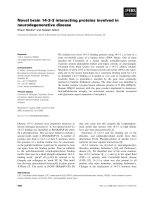
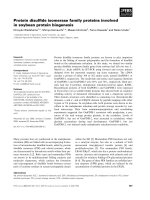
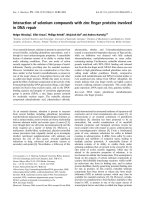
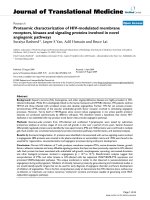
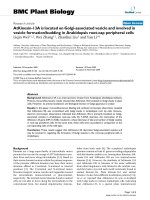


![pike - 2003 - studies on audit quality [aq]](https://media.store123doc.com/images/document/2015_01/06/medium_skm1420548229.jpg)